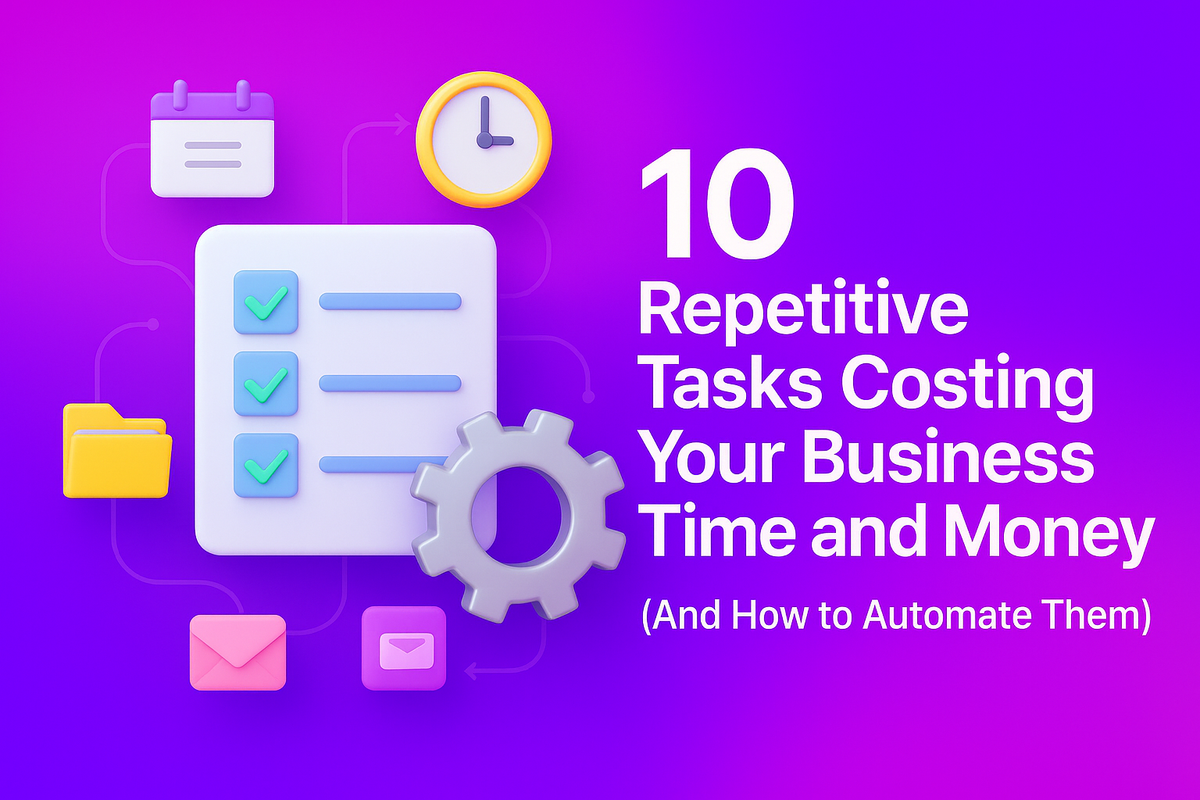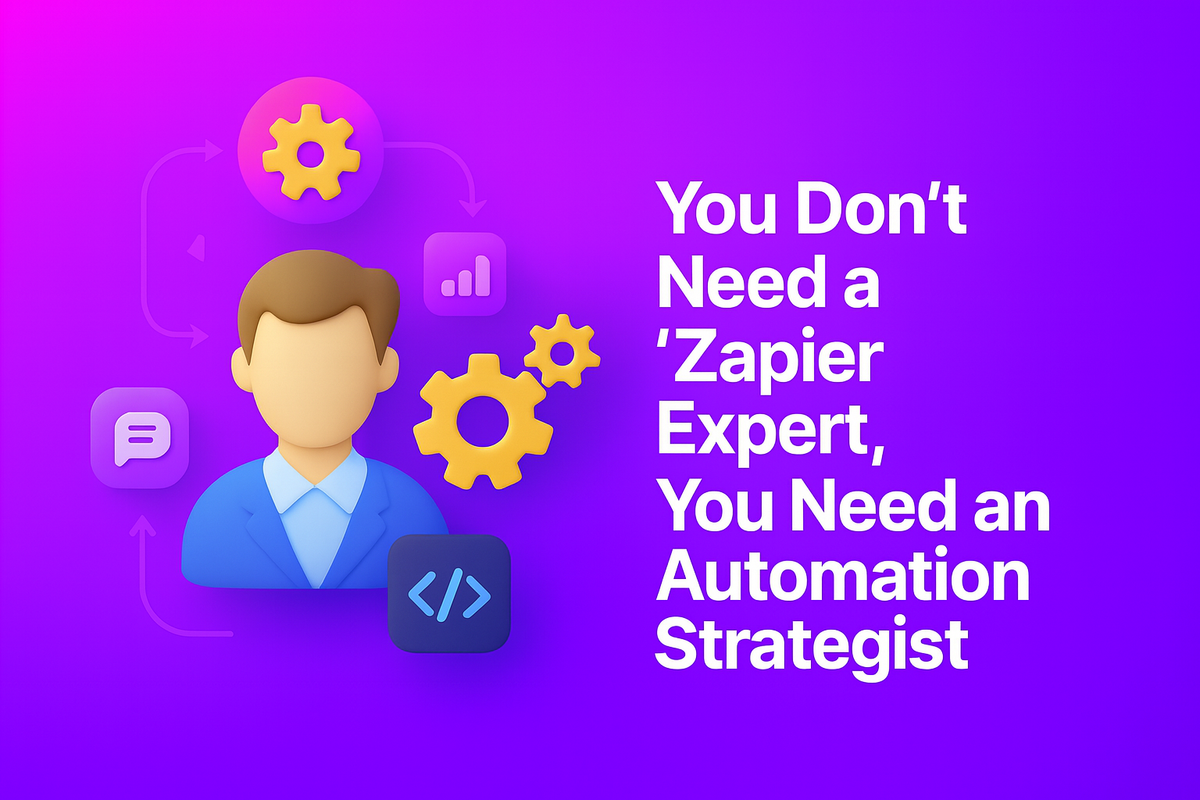
Does your business sometimes feel less like a well-oiled machine and more like one talented person frantically spinning plates?
As a founder, you're used to wearing multiple hats. In the early days, you were the sales team, the finance department, and the customer service desk. But as your business grows, that plate-spinning act becomes unsustainable.
A new sales order comes in, but the details are slow to reach the operations team. An invoice gets paid, but no one tells the project manager they can kick off the work. Information gets lost in email chains. Tasks fall through the cracks between departments. This isn't a sign of failure; it's a symptom of growth. But it's a symptom that can seriously limit your potential.
There's a strategic solution to this chaos: Business Process Automation (BPA).
Forget the confusing technical jargon. You don't need to be a tech wizard to understand or benefit from BPA. In this guide, we're going to break it all down in plain English, using a simple analogy to show you how this powerful concept can transform your business from a chaotic scramble into a streamlined, scalable operation.
So, What Actually is Business Process Automation?
At its core, Business Process Automation is a strategy for streamlining your entire business. It's not about automating a single task, but about redesigning and automating a whole chain of tasks that work together to achieve a business goal.
Think of it as creating a digital blueprint for how work gets done in your company. BPA connects your different departments—sales, finance, HR, operations—and teaches them how to pass information and tasks between each other automatically, following a set of rules you create.
To make this crystal clear, let's use an analogy every founder can appreciate: a busy restaurant.
The Restaurant Analogy: Your Business on a Plate
Imagine a small eatery with just one incredibly talented but overworked chef.
Phase 1: The Manual Kitchen (Your Business Today?)
The chef takes a customer's order by hand. He runs to the kitchen, cooks the meal, washes the dishes from the last order, runs back out to serve the food, and then processes the payment. He's a hero, but the service is slow, mistakes happen when he's rushed, and he can only serve a few tables at a time. This is many small businesses: one or a few key people doing everything manually.
Phase 2: Task Automation (A Small Improvement)
The chef gets a machine that automatically chops all his vegetables. This is great! It saves him 30 minutes every morning. He has automated a single task. This is Task Automation. It's like using a social media scheduling tool. It helps with one specific job, but it doesn't fix the overall chaotic process.
Phase 3: Workflow Automation (Connecting Two Dots)
Now, the chef sets up a simple system. When he places a finished dish on the pass, it presses a button that rings a bell for the server. This is an A-to-B connection: Dish is ready (Trigger) → Ring the bell (Action). This is Workflow Automation. It's a simple, linear flow that makes one part of the process smoother.
Phase 4: Business Process Automation (The Full Transformation)
This is where the magic happens. The owner decides to implement a real system—a BPA strategy.
- A customer places an order via a tablet at their table (Sales).
- The order is automatically routed to a screen in the kitchen (Operations).
- Simultaneously, the system checks the digital inventory to confirm all ingredients are in stock and reserves them for this dish (Inventory Management).
- When the chef marks the dish as "complete" on his screen, two things happen automatically:
- A notification is sent to the server's smartwatch to pick up the food (Operations).
- The customer's bill is automatically updated with the new item (Finance).
- When the customer pays their bill, the system automatically deducts the ingredients used from the inventory count and adds the revenue to the daily sales report (Finance & Analytics).
💡 The Key Insight
This is Business Process Automation. It's not just one task; it's a smart, interconnected system that manages an entire process from start to finish, touching multiple "departments" of the restaurant along the way. It's the difference between buying a faster knife and redesigning the entire kitchen for perfect flow.
The Key Difference: BPA vs. Workflow Automation
People often use these terms interchangeably, but the distinction is important for a founder to understand.
Workflow automation is a component of a larger BPA strategy. You need good workflows to have good BPA, but thinking in terms of BPA is about taking a 10,000-foot view of your entire business.
The Real-World Benefits of BPA for Your SME
Okay, the analogy is helpful, but what does this mean for your bottom line? Here are the concrete benefits of implementing a BPA strategy.
🚀 Radical Efficiency & Reduced Costs
When your systems handle the manual work, your team is freed up to focus on high-value activities like sales, strategy, and customer relationships. You can do more business without proportionally increasing your administrative headcount.
🎯 Near-Perfect Accuracy
Humans make mistakes. We have bad days, we get tired, we make typos. A well-designed automated process does not. It performs the task with 100% accuracy every single time, reducing costly errors in invoicing, data entry, and reporting.
⭐ A Superior Customer Experience
BPA ensures a smooth, professional, and fast experience for your clients. Onboarding is instant, communication is consistent, and they feel like they are dealing with a world-class company, because your processes are world-class.
🛡️ Ironclad Compliance and Standardization
BPA ensures that the process is followed the exact same way every time. This is crucial for maintaining quality standards and meeting any industry compliance regulations.
📈 Built for Scale
This is perhaps the most important benefit for an ambitious founder. BPA allows your business to grow without the growing pains. You can handle 100 new customers with the same streamlined process you used for 10. Your operations are built on a foundation that can handle volume.
What Processes Can You Automate? Some Common BPA Examples
Quote-to-Cash: The entire sales and finance lifecycle. A new signed quote automatically creates a customer in your accounting system, generates the initial invoice, sets up payment reminders, and notifies the operations team to begin work.
New Employee Onboarding: The entire HR and IT process. A signed offer letter triggers the creation of a user account, adds the employee to payroll, assigns them the standard onboarding training modules, and notifies their manager to schedule a welcome meeting.
Client Project Lifecycle: The complete journey from a signed contract to a final testimonial request. The system can handle project setup, phase-based invoicing, client update reminders, and a final feedback request, all triggered by project milestones.
BPA is Your Blueprint for Growth
Business Process Automation isn't about buying a single piece of software. It's a strategic way of thinking. It's about looking at the "white space" between your departments and building digital bridges to close the gaps. It's about creating a resilient, efficient, and intelligent blueprint for your business to run on, freeing you to be the founder you were always meant to be.
🤔 Over to You
Thinking about your own business right now, what is the one process that involves multiple people or departments and consistently causes the most delays or headaches?
Ready to design the blueprint for your business's future?
Understanding the concept of BPA is the first step. Applying it to your unique business operations is where the transformation truly begins. It can be hard to see the whole picture when you're in the frame.
We offer a free, no-obligation 20-minute Automation Opportunity Audit. In this session, we'll act as your strategic partner, helping you map out one of your core business processes and identify the key opportunities for automation that will deliver the biggest impact.

